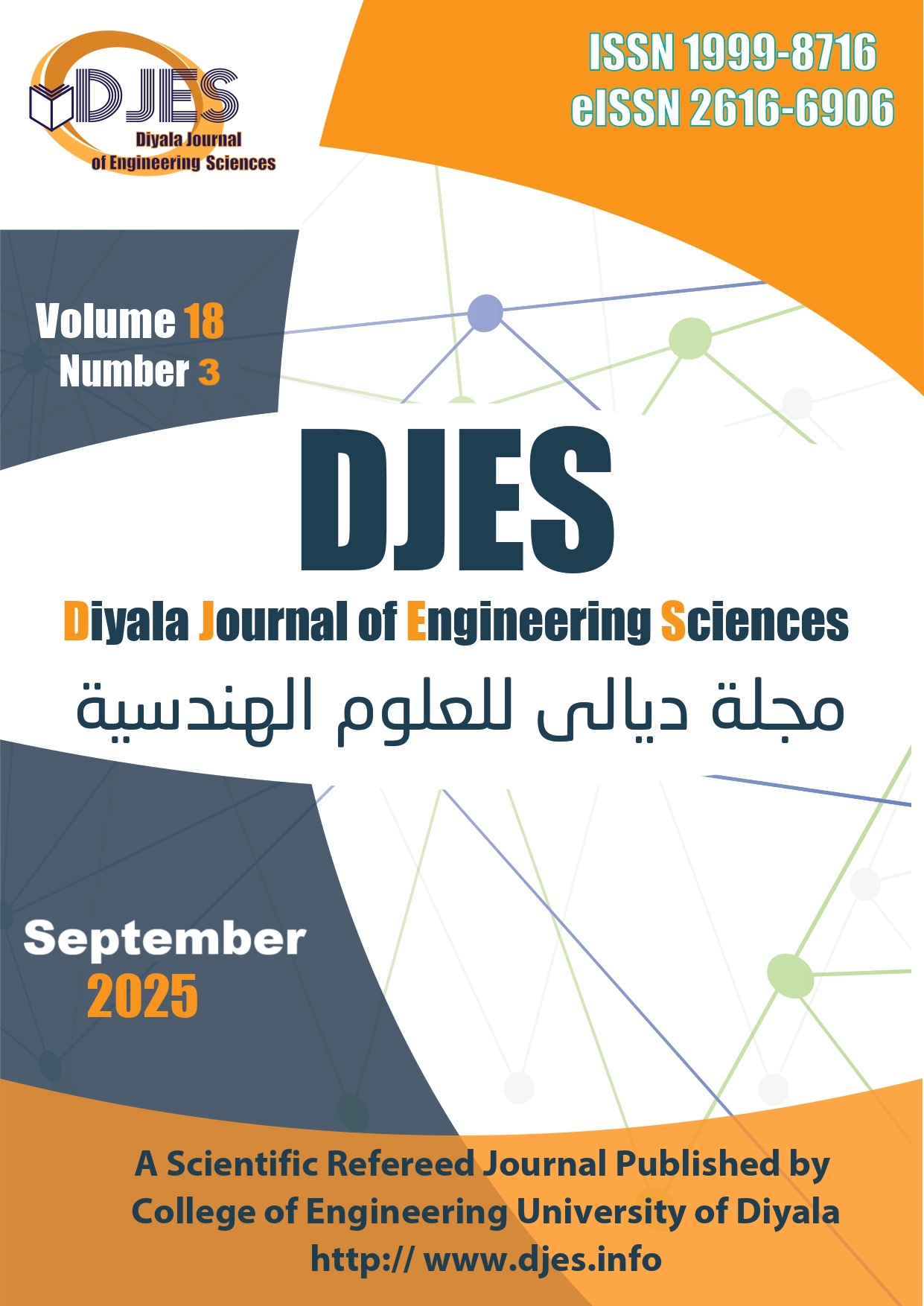Evaluation of Biochar derived from partial pyrolysis of Chara Algae for adsorption of lead and copper from aqueous solutions A
DOI:
https://doi.org/10.24237/djes.2025.18306Keywords:
Biosorption , Heavy metals , Remediation , Biochar, AlgaeAbstract
This study aimed to evaluate the efficiency of biochar (BC) produced from Chara algae via semi-anaerobic pyrolysis as an adsorbent for removing lead (Pb²⁺) and copper (Cu²⁺) ions from aqueous solutions in a batch system. The preparatory process involved washing the algal biomass with tap water and deionized water, followed by a two-stage drying process: solar drying (48 h) and then thermal drying (75°C, 24 h). Dried sample was then ground into fine particles (250–400 μm) and subjected to a semi-anaerobic heat treatment at temperatures between 400 and 600°C for 50 min to adjust the physicochemical properties of the biochar. The adsorption performance was studied under a range of operating conditions, including a range of pH (2–6), contact time (10–150 min), initial heavy metal ion concentrations (20–100 mg/L), temperatures ranging from 25 to 80°C, and various adsorbent concentrations (0.1–3 g/L). The adsorbent was characterized using advanced analytical techniques. Fourier transform infrared spectroscopy (FTIR) was used to identify the functional groups active in adsorption, scanning electron microscopy (SEM) to analyze the surface structure, and energy-dispersive X-ray spectroscopy (EDS) to determine the elemental composition and confirm metal adsorption. Under best conditions (pH 6, dosage 1.0 g/L), the maximum adsorption capacities recorded were 322 mg/g for Pb²⁺ and 196 mg/g for Cu²⁺. The dynamic adsorption studies further confirmed the removing heavy metals from aqueous media, indicating its promise for scalable water treatment. applications.
Downloads
References
[1] H. A. Alalwan, M. A. Kadhom, and A. H. Alminshid, “Removal of heavy metals from wastewater using agricultural byproducts,” J. Water Supply Res. Technol. - Aqua, vol. 69, no. 2, pp. 99–112, Mar. 2020.
DOI: 10.2166/aqua.2020.133
[2] M. Thakare et al., “Understanding the holistic approach to plant-microbe remediation technologies for removing heavy metals and radionuclides from soil,” Curr. Res. Biotechnol., vol. 3, pp. 84–98, 2021.
DOI: 10.1016/j.crbiot.2021.02.004
[3] S. K. Gunatilake, “Methods of removing heavy metals from industrial wastewater,” J. Multidiscip. Eng. Sci. Stud., vol. 1, no. 1, pp. 12–18, Nov. 2015.
[4] H. Sarma and M. N. V. Prasad, “Phytomanagement of polycyclic aromatic hydrocarbons and heavy metals-contaminated sites in Assam, north eastern state of India, for boosting bioeconomy,” in Bioremediation and Bioeconomy, Elsevier, 2016, pp. 609–626.
DOI: 10.1016/B978-0-12-802830-8.00024-1
[5] N. R. Lynch, T. C. Hoang, and T. E. O’Brien, “Acute toxicity of binary-metal mixtures of copper, zinc, and nickel to Pimephales promelas: Evidence of more-than-additive effect,” Environ. Toxicol. Chem., vol. 35, no. 2, pp. 446–457, Feb. 2016.
DOI: 10.1002/etc.3204
[6] M. Bilal et al., “Waste biomass adsorbents for copper removal from industrial wastewater—A review,” J. Hazard. Mater., vol. 263, pp. 322–333, Dec. 2013.
DOI: 10.1016/j.jhazmat.2013.07.071
[7] I. Noor et al., “Heavy metal and metalloid toxicity in horticultural plants: Tolerance mechanism and remediation strategies,” Chemosphere, vol. 302, p. 135196, 2022.
DOI: 10.1016/j.chemosphere.2022.135196
[8] X. Liu et al., “Membrane technology for rainwater treatment and reuse: A mini review,” Water Cycle, vol. 2, pp. 51–63, 2021.
DOI: 10.1016/j.watcyc.2021.08.001
[9] N. Ahalya, T. V. Ramachandra, and R. D. Kanamadi, “Biosorption of heavy metals,” Res. J. Chem. Environ., vol. 7, no. 4, pp. 71–79, 2003.
[10] P. N. Diagboya, B. I. Olu-Owolabi, F. M. Mtunzi, and K. O. Adebowale, “Clay-carbonaceous material composites: Towards a new class of functional adsorbents for water treatment,” Surf. Interfaces, vol. 19, p. 100506, 2020.
DOI: 10.1016/j.surfin.2020.100506
[11] S. N. Farhan, W. A. Mahmood, M. H. Ismael, A. A. Khadom, and A. M. A. Karim, “Biosorption of copper and lead ions using Chara algae,” Pak. J. Eng. Appl. Sci., vol. 29, pp. 1–6, Jul. 2021.
[12] M. U. Mustapha et al., “Microorganisms and biosorption of heavy metals in the environment: A review paper,” J. Microb. Biochem. Technol., vol. 7, no. 5, pp. 253–256, 2015.
DOI: 10.4172/1948-5948.1000219
[13] S. N. Farhan and A. A. Khadom, “Biosorption of heavy metals from aqueous solutions by Saccharomyces cerevisiae,” Int. J. Ind. Chem., vol. 6, pp. 119–130, 2015.
DOI: 10.1007/s40090-015-0038-8
[14] J. Lehmann and S. Joseph, Eds., Biochar for Environmental Management: Science, Technology and Implementation, 2nd ed. Routledge, 2015.
DOI: 10.4324/9780203762264
[15] J. Lehmann et al., “Biochar effects on soil biota—A review,” Soil Biol. Biochem., vol. 43, no. 9, pp. 1812–1836, 2011.
DOI: 10.1016/j.soilbio.2011.04.022
[16] Y. Ding et al., “Evaluation of biochar effects on nitrogen retention and leaching in multi-layered soil columns,” Water Air Soil Pollut., vol. 213, pp. 47–55, 2010.
DOI: 10.1007/s11270-010-0366-4
[17] W. Kwapinski et al., “Biochar from biomass and waste,” Waste Biomass Valor., vol. 1, pp. 177–189, 2010.
DOI: 10.1007/s12649-010-9024-8
[18] D. Mohan, A. Sarswat, Y. S. Ok, and C. U. Pittman, Jr., “Organic and inorganic contaminants removal from water with biochar, a renewable, low cost and sustainable adsorbent—A critical review,” Bioresour. Technol., vol. 160, pp. 191–202, 2014.
DOI: 10.1016/j.biortech.2014.01.120
[19] R. Wang et al., “Effects of chlortetracycline and copper on tetracyclines and copper resistance genes and microbial community during swine manure anaerobic digestion,” Bioresour. Technol., vol. 238, pp. 57–69, 2017.
DOI: 10.1016/j.biortech.2017.03.134
[20] Neto, Jorge SS, et al. "A review on the thermal characterisation of natural and hybrid fiber composites." Polymers 13.24 (2021): 4425. DOI:10.3390/polym13244425
[21] Losic, Dusan, et al. "Accounting carbonaceous counterfeits in graphene materials using the thermogravimetric analysis (TGA) approach." Analytical Chemistry 93.34 (2021).
DOI:11859-11867.10.1021/acs.analchem.1c02662
[22] A. Cu and A. Zn, “Biosorption of Cu²⁺ and Zn²⁺ by immobilized algae biomass of Chlorella kessleri,” Acta Metall. Slovaca, vol. 15, no. 4, pp. 255–263, 2009.
[23] A. Stoll and J. R. Duncan, “Comparison of the heavy metal sorptive properties of three types of immobilized, non-viable Saccharomyces cerevisiae biomass,” Process Biochem., vol. 32, no. 6, pp. 467–472, 1997.
DOI: 10.1016/S0032-9592(96)00093-3
[24] S. Shindo and M. Kamimura, “Immobilization of yeast with hollow PVA gel beads,” J. Ferment. Bioeng., vol. 70, no. 4, pp. 232–234, 1990.
DOI: 10.1016/0922-338X(90)90054-Z
[25] T. Wei et al., “Performance of heavy metal-immobilizing bacteria combined with biochar on remediation of cadmium and lead co-contaminated soil,” Environ. Geochem. Health, vol. 45, pp. 6009–6026, 2023.
DOI: 10.1007/s10653-023-01605-9
[26] M. Varnaseri-Ghandali et al., “Adsorption of multi-heavy metals from aqueous solution by wheat straw and its biochar loaded with MnO₂ nanoparticles: Characteristics and mechanisms,” Environ. Dev. Sustain., 2024.
DOI: 10.1007/s10668-024-05238-5
[27] Tan, X. et al. (2015) ‘Application of biochar for the removal of pollutants from aqueous solutions’, Chemosphere, 125, pp. 70–85.
[28] X. Lin, J. Zhou, and S. Sun, “Cadmium and lead removal by Mg/Fe bimetallic oxide-loaded sludge-derived biochar: Batch adsorption, kinetics, and mechanism,” Environ. Sci. Pollut. Res., vol. 30, pp. 86866–86878, 2023.
DOI: 10.1007/s11356-023-28574-x
[29] T. Liu et al., “Structural characteristics of biochars made from different parts of corn straw and their adsorption performances for methylene blue,” J. Water Process Eng., vol. 68, p. 106562, 2024.
DOI: 10.1016/j.jwpe.2024.106562
[30] Tan, X. et al. (2015) ‘Application of biochar for the removal of pollutants from aqueous solutions’, Chemosphere, 125, pp. 70–85. doi: 10.1016/j.chemosphere.2014.12.058
[31] X. Shi et al., “The Application of Biochar as Heavy Metals Adsorbent: The Preparation, Mechanism, and Perspectives,” Int. J. Environ. Res., vol. 18, p. 41, 2024.
DOI: 10.1007/s41742-024-00592-8
[32] S. Gu and C. Q. Lan, “Effects of culture pH on cell surface properties and biosorption of Pb(II), Cd(II), Zn(II) of green alga Neochloris oleoabundans,” Chem. Eng. J., vol. 468, p. 143722,2023.
DOI: 10.1016/j.cej.2023.143579.
[33] J. Di et al., “Adsorption behaviors and mechanisms of Cu²⁺, Zn²⁺, and Pb²⁺ by magnetically modified lignite,” Sci. Rep., vol.1 12, p. 1394, 2022.
DOI: 10.1038/s41598-022-05453-y
Downloads
Published
Issue
Section
License
Copyright (c) 2025 Saja A. Ismael, Salah N. Farhan

This work is licensed under a Creative Commons Attribution 4.0 International License.












